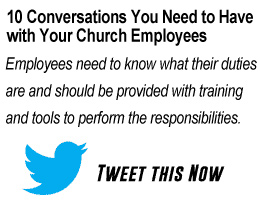People work for a ministry because they feel called and have a passion to help fulfill its mission. This type of committed employee is what great organizations are made of. However, helping employees maintain that passion and commitment takes strategy and proactive communication.
Engaged employees consistently perform at higher levels because they believe in what they are doing and the organization makes them feel valued and appreciated. Maintaining this level of employee engagement requires communicating often and having direct conversations with employees.
These conversations are intended to communicate organizational priorities and help to uncover information that can improve the work environment and the process of how work gets done.
10 Conversations You Need to Have with Your Church Employees – Things Every Church Employee Needs to Hear from You
“This is what your job entails.”
Employees need to know what their job duties are and should be provided with the training and tools to perform those job responsibilities. This includes having a written job description that articulates job duties, a conversation with their supervisor to explain the document and to answer any questions or concerns about the job.
“This is what I expect.”
Talk to employees and help them understand job requirements and your expectations for job performance. Have this conversation on a regular basis so the employee has the opportunity to ask questions or seek help with barriers to getting things done.
“This is what you can expect.”
We all come from different backgrounds and have dissimilar employment experiences. Employees need to know what is expected of them and understand management practices and policies. For example, employees should understand what rewards will be given when performance expectations are met as well as what the consequences are, when they are not.
“This is your mentor”
Everyone in a new job needs a go-to person to help transition them into their new role. This person should be responsible to help mentor the employee on organizational culture, internal processes and problem solving.
Providing employees with a mentor can expedite the onboarding process and ensure that all employees are oriented to the organization in the same way.
“We are doing this because…”
Employees need to understand why they do, what they do, and how their job tasks help support the mission of the church. Sometimes, church staff needs help understanding that what they do is crucial to achieving the mission.
For example, a part-time custodial person, who cleans the building when no one is around, may need to be reminded that what he does helps to create an aesthetically pleasing environment that members, volunteers and visitors enjoy. Take the time to continually restate the mission, not only to employees, but also to volunteers and church members.
“You and your family are important.”
Working for a church is not always easy, and anyone with a family has felt the tension between work and home responsibilities. This tension can become a distraction, if not managed.
Managers should communicate support and understanding of family obligations and back it by making concessions to accommodate family responsibilities when they conflict with work responsibilities. This kind of empathy helps employees feel valued and cared for.
“How can I help you?”
Sit down with employees and ask how you can help them. This simple question opens the door for information sharing that can uncover barriers to getting the job done.
For example, if a custodial employee is responsible for cleaning the carpet, and the carpet cleaner is broken, asking this question can lead to a conversation that reveals the broken equipment. This then allows you to fix their problem by helping to expedite the process of getting the machine repaired or purchasing a new one.
“Are there any changes we could make that would make your job easier?”
Employees frequently work with broken processes that they don’t have the ability or authority to change. Often, these employees follow procedures that may be outdated and disconnected with current needs of the organization.
Unfortunately, this often results in time wasted performing tasks that may add no value. Church leadership should have an interest in identifying areas that need change, and provide a process to improve internal operations.
“Are there any tools or equipment that could help you do your job more efficiently?”
It is difficult to keep up with changing technology, and most churches can’t afford to purchase the newest gadget or software program. However, there are times when investing in a new technology can save time and money.
Talk to your employees and let them share recommendations about tools or equipment in their area of expertise that could improve efficiencies. Ask them to research options and put a proposal together that describes what problem would be solved, the cost benefit and price comparisons from a couple of vendors.
Let them do the legwork, don’t make any promises, but if it is a justifiable solution, offer to take the request to the budget committee for approval.
“Great job, thank you!”
Most employees don’t hear these words often enough. Take the time to acknowledge a job well done, a completed project or the success of a big church event. Stop to thank the employee for their hard work and let them know how much you appreciate their efforts.
Working for a church can have its challenges, but if leadership understands the needs of employees and helps them do their job better by asking a few questions, they can remove barriers to getting work done and help to create a culture that engaged and passionate employees thrive in!

